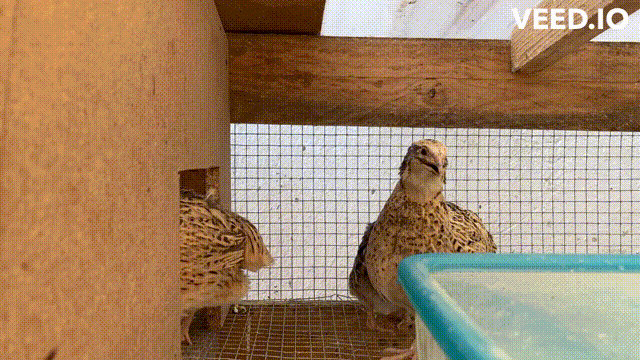Quail are excellent at tolerating a wide range of temperatures. They can survive extreme colds in the winter (as I explained in this article) and warm days. If you live in a hot climate or have hot summers, you may wonder if your weather is too hot for these birds.
Quail thrive in temperatures of 60°F (15°C) and 75°F (24°C), but they can tolerate temperatures of up to 100°F (37.5°C). However, prolonged exposure to temperatures above 90°F (32°C) can lead to heat stress and health issues.
What temperature is too hot for quail?
Quail are very hardy animals used to a wide range of temperatures. In nature, they can survive the coldest of colds and the hottest of hots, with temperatures ranging from 0°F (-18°C) to 100°F (38°C). To do this, they resort to some tricks by using available resources.
In their natural habitat, they rely on shelters provided by nature, and they use bushes, forests, and other hiding places to escape from the direct heat of the Sun. By staying out of direct sunlight or withdrawing in a hiding place where the breeze has some cooling effect, they can survive hot days.
Learn how to raise your own quail and have an unlimited supply of eggs and meat.
Since quail can’t move in captivity, you must provide them with a shelter that gives them sufficient protection against prolonged and direct sunlight. If they lack good ventilation and are exposed to direct sunlight with no place to hide, they are more likely to suffer on hot days.
Since they sweat glands, they can’t rid themselves of excess body heat through evaporation like us humans.
This is what I have experienced with my quail. With temperatures of up to 90°F (32°C), they behave normally, and they find it easy to cope with. Their normal body temperature is 100°F (37.5°C), which is their threshold of tolerance. As the temperature rises, they get less active and look for the coolest spot in the cage.

The brooder temperature must be kept close to 100°F (37.5°C) for quail chicks in the first few days and gradually lowered as they grow feathers.
My adult birds drink a lot more on hot days than they do otherwise. Fresh drinking water is essential, and it helps them with temperature regulation.
Signs that your quail are hot
Keeping an eye on your quail is good animal husbandry. This is especially important when the temperatures are extreme. Check on your birds regularly, and observe their behavior.
If you pay attention to them, you will notice patterns of behavior. Some signs that I can see when my quail are too hot are:
Panting
Panting is a common sign that your birds are feeling too hot. They open their beaks, stick out their tongue, and breathe in and out rapidly.

Wings spread
They may spread their wings away from their body in an attempt to dissipate heat and increase air circulation around their bodies.
Lethargy and reduced activity levels
Heat-stressed quail may become lethargic and show a lack of energy. They may appear less active than usual and spend more time resting or sitting quietly.
Decreased appetite
When quail are too hot, their appetite may decrease. They may eat less or show disinterest in food and water.
Increased water consumption
Quail may drink more water than usual when they are feeling hot. Ensure that they have plenty of water to drink.
Other signs that I have not experienced in my flock, but they can occur, especially if the birds are exposed to direct sunlight, are:
Pile-up behavior
When quail are too hot, they may huddle or pile up on top of each other. This behavior is an attempt to find shade or reduce their exposure to direct sunlight and heat.
Reduced egg production
Heat stress can negatively impact egg production in quail. If your quail suddenly decrease their egg-laying or stop laying altogether during hot weather, it could be a sign of heat-related stress.
The best location for quail in the Summer
To protect your quail from heat stress and potentially from death, you must choose the location of their habitat wisely.
Aviary
If you keep your quail in an aviary, provide them with plenty of bushes and places to hide from direct sunlight.
At least a part of the aviary should have a roof for protection, which provides shade and keeps them safe from the elements.
Aviaries have good ventilation by nature, which allows the breeze to have some cooling effect.
Provide your quail with plenty of water to drink.
Indoor
It is more challenging to regulate the temperature of quail cages indoors, such as in a barn.
If your quail are in a shaded area that doesn’t get too hot, or if the location has air conditioning, this is ideal for quail. But let’s face it: indoor locations are often sheds or barns that get very hot when the Sun hits the roof, and they don’t offer much ventilation.
Providing quail with water is very important, but if your quail get too stressed and the temperature rises to 100°F (38°C), give them some ventilation with a fan directed at the cage.
Outdoor cage
Pick the location of your outdoor cage strategically. It should be in a part of your garden that doesn’t get direct sunlight in the sunniest hours of the day (from 12 noon to 3 pm).
Trees and the northern sides of buildings offer protection.
Don’t keep your quail in a fully enclosed cage. I find it useful to have my cage divided into two parts: one is a closed part that protects from strong winds and rain, and another one with no walls.
Cages with fully transparent roofs have a greenhouse effect and get hot very easily. If you have a transparent roof, cover it on hot days to keep out the rays of the Sun.
Plenty of water available for your quail is essential.
Related questions
Can quail die from heat?
Quail are very resilient but can die if exposed to heat for long or if the temperature rises too suddenly. Thankfully, this isn’t very common, and it can be prevented with hydration, ventilation, and shade.
Do quail go for a swim to cool down?
Even though quail love water, they are not good at swimming and don’t go into the water to cool down.
Happy quailing!

